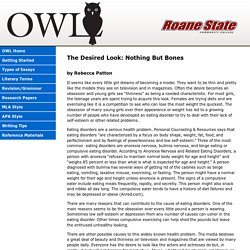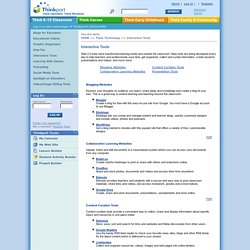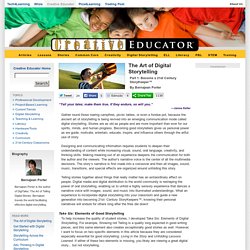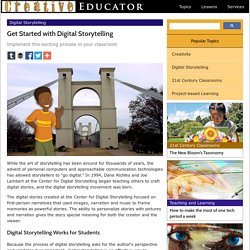

shapal
The Desired Look: Nothing But Bones. By Rebecca Patton It seems like every little girl dreams of becoming a model.

They want to be thin and pretty like the models they see on television and in magazines. Often the desire becomes an obsession and young girls see “thinness” as being a needed characteristic. For most girls, the teenage years are spent trying to acquire this look. Females are trying diets and are exercising like it is a competition to see who can lose the most weight the quickest. Eating disorders are a serious health problem. There are many reasons that can contribute to the cause of eating disorders. There are other possible causes to this widely known health problem. There really is no single reason that a person acquires an eating disorder.
Works Cited Anorexia Nervosa and Related Eating Disorders, Inc. Personal Counseling and Resources. Web 2.0/Interactive Tools. Web 2.0 tools have transformed learning inside and outside the classroom.

New tools are being developed every day to help teachers and professionals save time, get organized, collect and curate information, create dynamic presentations and videos, and much more. Blogging Websites Express your thoughts on subjects you teach, share ideas and knowledge and create a blog of your own. This is a great way to extend learning and teaching beyond the classroom. Blogger Create a blog for free with this easy-to-use site from Google. Collaborative Learning Websites Upload, share and edit documents in a cloud-based system where you can access your documents from any computer.
The Art of Digital Storytelling. 24 5Edmodo4 1139 “Tell your tales; make them true.

If they endure, so will you.” —James Keller Gather round those roaring campfires, picnic tables, or even a fondue pot, because the ancient art of storytelling is being revived into an emerging communication mode called digital storytelling. Stories are as old as people and are more important than ever for our spirits, minds, and human progress. Designing and communicating information requires students to deepen their understanding of content while increasing visual, sound, oral language, creativity, and thinking skills. Telling stories together about things that really matter has an extraordinary effect on people. Take Six: Elements of Good Storytelling To help increase the quality of student stories, I developed Take Six: Elements of Digital Storytelling.
Living in the Story. The Art of Digital Storytelling. Get Started with Digital Storytelling. Implement this exciting process in your classroom While the art of storytelling has been around for thousands of years, the advent of personal computers and approachable communication technologies has allowed storytellers to “go digital.”

In 1994, Dana Atchley and Joe Lambert at the Center for Digital Storytelling began teaching others to craft digital stories, and the digital storytelling movement was born. The digital stories created at the Center for Digital Storytelling focused on first-person narratives that used images, narration and music to frame memories as powerful stories. The ability to personalize stories with pictures and narration gives the story special meaning for both the creator and the viewer.
Digital Storytelling Works for Students. Digital Play. In the University of Bristol’s Education Endowment Foundation‘s recent study on Neuroscience and Education, (Howard-Jones, 2014), there is an interesting section on Learning Games.

Classroom practice and neuroscientific research The review ”considers the extent to which insights from the sciences of mind and brain influence, or are close to influencing classroom practice”, summarising “existing evidence about approaches and interventions that are based, or claim to be based, on neuroscience evidence.” Making-Peace-Telling-Our-Story.pdf. Energizers, Warm-ups, Starters, and story-telling games. Using Augmented Reality in the EFL Classroom. Speaker: Stephen Pilton (King’s Education, Oxford) Using Augmented Reality in the EFL Classroom Stephen Pilton’s opens his talk by asking us to imagine we are students at his language school in Oxford. We can see different images moving on the screen; a poster advertising the language programmes at his school, a music club and a local café. He then takes us to a page from The Lizzie Bennet Diaries (US drama based on Jane Austin’s Pride and Prejudice) and finally to a student worksheet with gap-fill exercises on phrasal verbs.
All very different types of information, but all related to student life at the language school. So how does this happen? This is augmented reality, where we superimpose videos over images to take the viewer into an imagined, but real-life setting. The Material Writer’s Essential Toolkit – MaWSIG PCE at IATEFL 2015. Workshop summaries. IATEFL 2015 has kicked off, and – yes, this year I’m attending it.

Feeling incredibly lucky and very grateful to my company, without whose support I wouldn’t have been able to go! Today I spent a delightful day at MaWSIG pre-conference event. There were eight information-packed sessions and workshop focusing on practical hands-on ideas useful for any materials writer, no matter how experienced you are. Below is a brief overview of the day – if you want to find out more, scroll down to detailed summaries. After a brief introduction by Nick Robinson, Sue Kay gave a session on writing multiple-choice questions. A theme that came up in two talks was the changing role of ‘non-visuals’ in ELT. Nick Tims gave a wonderful, lively session in which he made a very strong point that whenever you find yourself frequently doing a certain action in several clicks, you should find a tool that does that action in one click.
Below are the notes that I took during the sessions. Disadvantages: More tips: 2.